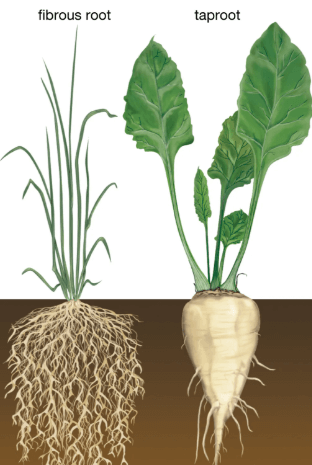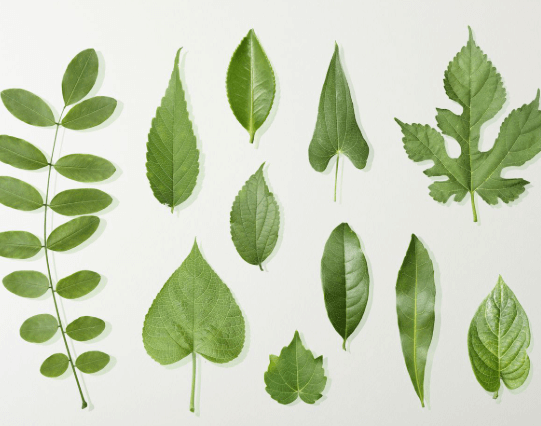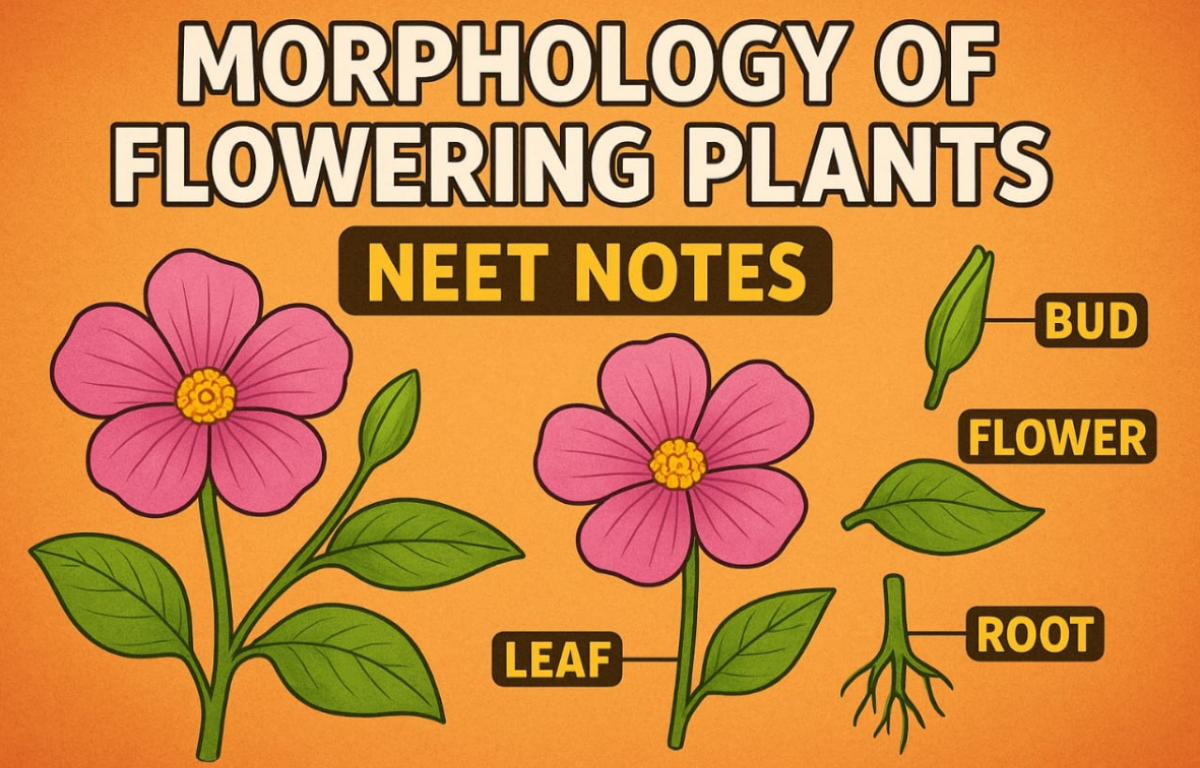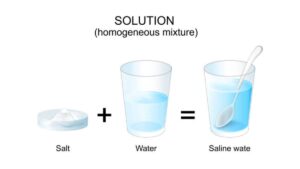Morphology of Flowering Plants NEET Notes: Have you ever spotted a flower and found yourself wondering what other secrets it held? The morphology of flowering plants tells us how this morphology—the roots, stems, leaves, and flowers—individually contributes to the plant’s survival and reproduction. For NEET aspirants, this chapter is a gem that describes and explains plant structure in a straightforward, scientific manner.
The roots, which provide stability, and the stems, which support life, as well as the flower that generates the next generation all require your detailed attention. In these NEET notes, we describe and explain all the key concepts of modifications of roots and stems, leaf venation patterns, inflorescence, and floral formulae. With this knowledge, you will not only hone your understanding of the basics of Botany but will also make you NEET–ready.
Why are the Morphology of Flowering Plants NEET Notes Important?
Morphology of Flowering Plants is an important topic in the NEET Biology Syllabus because it is simple, high-weightage, and directly scoring. With smart preparation, you can secure full marks from this chapter and boost your overall NEET score.
1. High Scoring Chapter
Every year, NEET asks multiple direct and indirect questions from this chapter. The concepts are not too tough, but many students get confused because of examples and tricky statements. If you prepare it well, this becomes a sure-shot scoring topic.
2. Foundation for Other Botany Topics
Morphology builds the base for chapters like Plant Diversity, Anatomy, and Physiology. Once you clearly know the parts of root, stem, leaf, flower, fruit, and seed, you can easily connect them with higher-level plant functions.

3. Direct Application in MCQs
Most questions asked are straightforward — like types of inflorescence, placentation, fruit types, or modifications. If you remember the diagrams and examples properly, you can answer within seconds without wasting time.
4. Easy to Revise with Diagrams & Examples
This chapter is full of simple diagrams and real-life examples (like mustard, pea, mango, maize, sunflower). Once you visualize them, it becomes easy to remember and revise quickly before the exam.
Morphology of Flowering Plants Class 11
Morphology is a branch of biology that studies the external form, shape, and structure of plants. In flowering plants, it mainly focuses on two types of parts: Vegetative parts – roots, stems, and leaves, which help in growth and survival. Reproductive parts – flowers, fruits, and seeds, which help in reproduction and the continuation of the species. This topic is very important for Class 11 students because it forms the base of botany, and for NEET aspirants, it helps in plant identification, classification, and solving many direct questions based on examples and diagrams. In very simple words, we can say – Morphology tells us how a plant looks from the outside and how its parts are arranged.
Vegetative Parts of Flowering Plants
Vegetative parts are the non-reproductive structures of a plant. They do not take part in sexual reproduction but are very important for growth, nutrition, and survival. These part in the morphology of Flowering plants is further divided into 3 different parts: The root, stem, and leaf. Where: Root = Absorption + Anchorage, Stem = Support + Transport +, and Leaf = Photosynthesis + Transpiration
1. The Root – The Anchor of Life
The root is the underground part of the plant that develops from the radicle. It anchors the plant, absorbs water and minerals, and sometimes stores food. Roots are of three types: tap, fibrous, and adventitious. Modifications help in storage (carrot), respiration (mangroves), and support (banyan prop roots). It is generally non-green and grows below the soil. The roots of a flowering plant help the plant to absorb underground water and take nutrients from the soil. It also helps the plant attach to the soil.

Main functions of Roots:
- Anchors the plant in the soil.
- Absorbs water and minerals.
- Stores food in some plants.
Types of Root Systems:
- Tap Root – one main root with branches (e.g., pea, mustard).
- Fibrous Root – many roots of similar size (e.g., wheat, rice).
- Adventitious Root – roots arising from parts other than the radicle (e.g., grass, banyan).
Modifications:
- For storage (carrot, radish).
- For respiration (pneumatophores in mangroves).
- For support (prop roots in banyan).
2. The Stem – The Life Line
The stem develops from the plumule and grows upward, bearing branches, leaves, flowers, and fruits. It transports water, minerals, and food through xylem and phloem. Stems also modify to perform special functions like storage (potato), climbing (tendrils), photosynthesis (cactus phylloclade), and protection (thorns in bougainvillea). It is usually green, aerial, and upright.
Main functions:
- Supports branches, leaves, flowers, and fruits.
- Transports water, minerals, and food through xylem and phloem.
- Sometimes stores food.
Modifications:
- For storage – potato (tuber), ginger (rhizome).
- For climbing – tendrils in grapes, passion flower.
- For defense – thorns in bougainvillea.
- For photosynthesis – cactus stem (phylloclade).
3. The Leaf – The Food Factory
The leaf is the main photosynthetic organ, called the “food factory” of the plant. It consists of a leaf base, petiole, and lamina. Veination can be reticulate (dicots) or parallel (monocots). Leaves may be modified for food storage (onion), climbing (pea tendrils), or insect trapping (pitcher plant, Venus flytrap). It develops from the node of a stem and is usually green and flat.

Main parts:
- Leaf base – attaches the leaf to the stem.
- Petiole – stalk of the leaf.
- Lamina – broad, flat part.
Venation (arrangement of veins):
- Reticulate – net-like (dicots, e.g., hibiscus).
- Parallel – veins run parallel (monocots, e.g., banana).
Functions of Leaves:
- Photosynthesis (food preparation).
- Transpiration (loss of water).
- Gas exchange.
Modifications:
- Insect-catching (pitcher plant).
- Climbing (pea tendrils).
- Food storage (onion, garlic).
The Flower – The Reproductive Part
The flower is the reproductive structure of angiosperms and the most attractive part of the plant. It develops on the stem and takes part in sexual reproduction. Flowers produce fruits and seeds after fertilization. A typical flower arises from the node of the stem and is attached by a stalk called a pedicel. They may be complete or incomplete, and can be unisexual or bisexual depending on their whorls.
Parts of a Typical Flower (4 Whorls)
| Different Parts of a Typical Flower | |
| Parts | Description |
| Calyx (Sepals) |
|
| Corolla (Petals) |
|
| Androecium (Stamens – Male Reproductive Part) |
|
| Gynoecium (Carpels/Pistil – Female Reproductive Part) |
|
Different Types of Flowers
Complete Flower
- Has all four whorls (calyx, corolla, androecium, gynoecium).
- Example: Hibiscus, mustard.
Incomplete Flower
- Missing one or more whorls.
- Example: Cucumber (sometimes lacks petals).
Bisexual Flower
- Has both an androecium and a gynoecium (male + female).
- Example: Hibiscus, mustard.
Unisexual Flower
- Has either an androecium (male) or a gynoecium (female).
- Example: Papaya, cucumber.
Fruit – Nature’s Package of Seeds
The fruit is a ripened ovary formed after fertilization. It protects the developing seeds and helps in their dispersal. Fruits may be true, false, dry, or fleshy depending on their origin and structure. They play an important role in reproduction, seed protection, and spreading plants to new areas. There are many different types of Fruits:
| Types of Fruits | Description | Examples |
| True Fruit | Develops only from the ovary after fertilization. | Mango, tomato. |
| False Fruit | Develops from the ovary + other floral parts like the thalamus. | Apple, cashew, pear. |
| Dry Fruits | The pericarp (fruit wall) is dry. May split open (dehiscent) or remain closed (indehiscent). | pea, mustard, sunflower |
| Fleshy Fruits | Pericarp is thick, soft, and juicy. | Banana, orange, grape. |
Seed – The Tiny Powerhouse
A seed is the mature, fertilized ovule that contains the embryo of a new plant. It is the final product of sexual reproduction in flowering plants. Seeds protect the embryo, store food for its growth, and help in dispersal. They may be monocot (maize) or dicot (bean).
Different Parts of a Seed
A seed is a small structure that carries the future plant inside it. Before studying its parts, it is important to know that a seed consists of protective layers, food storage tissues, and an embryo that develops into a new plant.
- Seed Coat – Protective outer covering.
- Embryo – The baby plant, consisting of:
- Radicle (root part).
- Plumule (shoot part).
- Cotyledons – Seed leaves that store food.
- Endosperm – Nutritive tissue in some seeds (mainly monocots).
Types of Seeds
There are two different types of seeds: Dicot seeds and monocot seeds. For more details about the types of seed, students are advised to carefully go through the table below:
| Types of Seeds | Description |
| Dicot Seeds |
|
| Monocot Seeds |
|










 NEET Preparation Strategy 2026: Detailed...
NEET Preparation Strategy 2026: Detailed...
 Free NEET Sample Papers 2026 PDF | Downl...
Free NEET Sample Papers 2026 PDF | Downl...
 Salt Analysis NEET Notes, Check Importan...
Salt Analysis NEET Notes, Check Importan...









